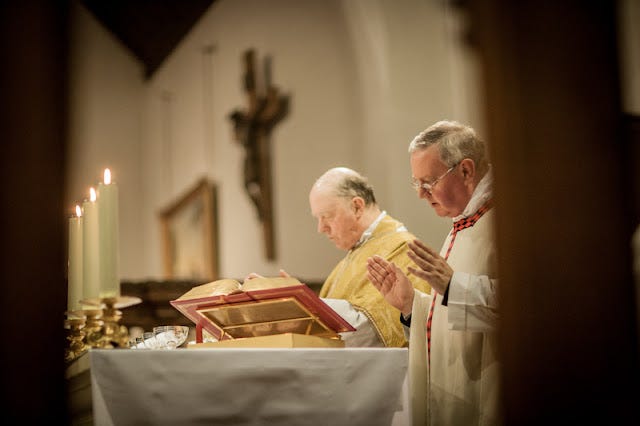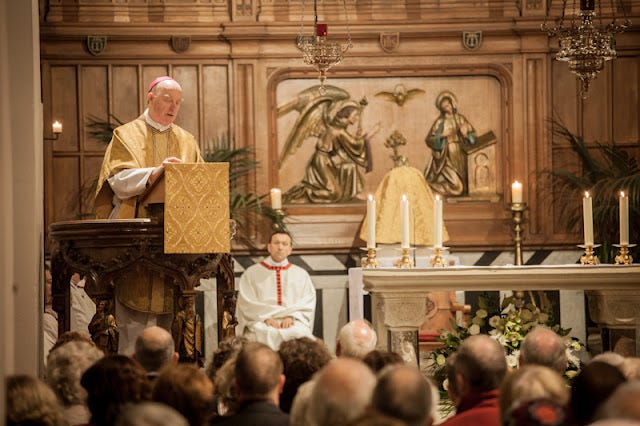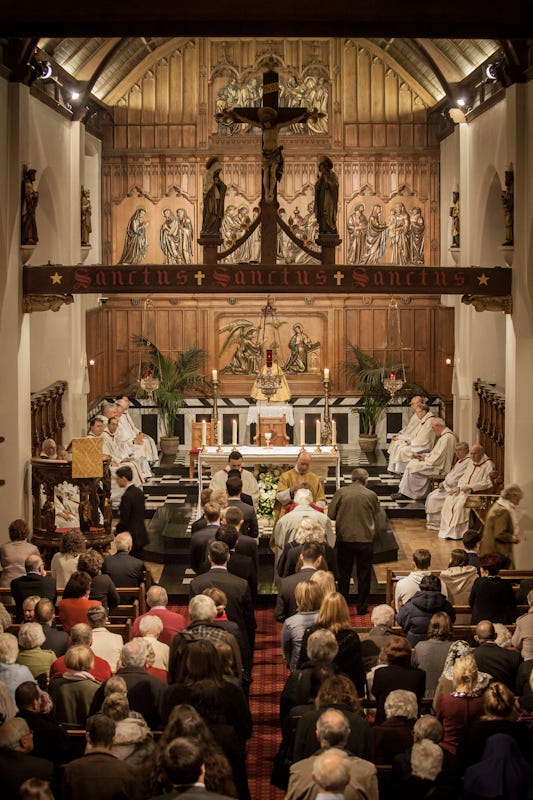† Bishop Thomas McMahon (1936–2025)
A Complex Legacy of Unity and Tension
Bishop Thomas McMahon, Bishop Emeritus of Brentwood, died peacefully on 24 November 2025 at his home in Stock. His passing marks the end of a long and influential tenure. Yet, his legacy is not unambiguous: it invites not only gratitude, but honest reflection.
A Shepherd Committed to Vision and Its Costs
Thomas McMahon served as Bishop of Brentwood from 1980 until 2014. He was my Bishop for most of my life. It is extraordinary how this shapes you and the Catholic community in which you live. And it makes you think just how important the role of a bishop actually is.
He is widely remembered as a man of liturgical vision. He was the driving force behind the building of the new Brentwood Cathedral, a classical-style building designed to embody his belief that beauty helps draw the faithful toward God. As he said in the 25th anniversary Mass, the cathedral should be “a model … in worship … in music … in art and architecture.”
But not everyone saw the cathedral project as a faithful realisation of Vatican II’s liturgical vision. On the contrary, many critics, and I count myself very much among them, have argued that what was presented as a renewal in the spirit of the Council ended up as something quite different: essentially a Palladian mansion, a large classical shell more at home in a country house catalogue than in the organic, people-centred worship the Council envisaged. The building’s heavy reliance on a Quinian-Terry classical idiom and its emphasis on monumentality work against the Council’s repeated insistence that liturgy be an assembly’s active, conscious participation in the paschal mystery, not the staging of a theatrical or museum-like backdrop.
If Sacrosanctum Concilium intended the liturgy to form and nourish the faithful, to be the “source and summit” of ecclesial life, fostering active participation and communal prayer, then the finished cathedral looks, to many of us, like a failure of reception rather than a sensitive adaptation. The architecture here feels cold and domestic rather than sacramental; the classical ornament exists without the deeper “classical Catholic” grammar of sacramental orientation that once helped shape churches as houses of God rather than showrooms of taste. The result for some worshippers has been disorientation rather than sanctification; a space that can feel secular and chaotic at the point of worship, rather than ordered toward the mysteries it is meant to reveal.
Ecumenism: Bridge-Builder — or Too Ready to Compromise?
McMahon’s commitment to Christian unity was integral to his ministry. He saw ecumenism not as a secondary concern, but as central to his vision of the Church. In his homily at his 25th anniversary Mass, he echoed Christ’s prayer “for the oneness of his Church” and emphasised working “closely with all other Churches and Faiths.”
Yet, from my point of view, this vision has failed. Indeed, there is uneasiness about the ecclesiology that underpins such a posture. Vatican II’s decree on ecumenism, Unitatis Redintegratio, did not simply call for gestures of friendship, it also proposed a new understanding of how non-Catholic Christians relate to the Church. Critics argue that this has sometimes led to a watering down of Catholic distinctiveness, a kind of “relativism” in which doctrinal clarity gives way to polite cooperation.
In my own reflections, I have raised the question: was McMahon’s ecumenical zeal always balanced with a robust Catholic identity? Or did his openness at times undervalue the weight of tradition. There is a real worry, now given greater authority with the benefit of hindsight, that the kind of generous ecumenism championed by Bishop McMahon risked endorsing a more sentimental unity, rather than a unity grounded in doctrinal truth. There can be no doubt that the Church of England has only moved further away from unity since the Second Vatican Council by any measure one cares to consider.
Another way to express this might be to say that the horse Bishop Thomas backed at Vatican II came in last.
A Pastoral Heart, Even in Critique
Despite these reservations, I do not wish to diminish the genuine care, pastoral sensitivity, and courage that Bishop McMahon brought to his ministry. His presence, especially in difficult moments, was deeply consoling. I remember, as before, how he wrote to me with sincere compassion after the death of my daughter, not offering trite platitudes, but acknowledging grief with a steady, caring faith.
That duality, a man confident (perhaps a little too confident) in his architectural ability, someone whose priorities raise significant theological questions, and yet a man who displayed a genuine pastoral vision, care for his diocese and flock and real heart, is precisely why his legacy matters so deeply. He was neither a simple hero nor an unflawed moderniser; he was a bishop shaped by his own convictions, wrestling with how to incarnate his vision in a changing Church.
Legacy and Challenge
As we commend Bishop Thomas McMahon to the Lord’s mercy, I hope we also learn from his life, the good and the difficult. He reminds us that building for the Church is not just about bricks, stone, or liturgical plans; it is about spiritual architecture, about forming souls and shaping communal identity.
May we pray for him, yes, but also reflect: how do we continue the work he began — building beauty, seeking unity — without losing the prophetic edge that calls the Church back to her deepest truths?
Requiescat in pace, Bishop McMahon. May your resting place be as serene as the vision you tried to build — and may your work continue to provoke, challenge, inspire, and guide.





